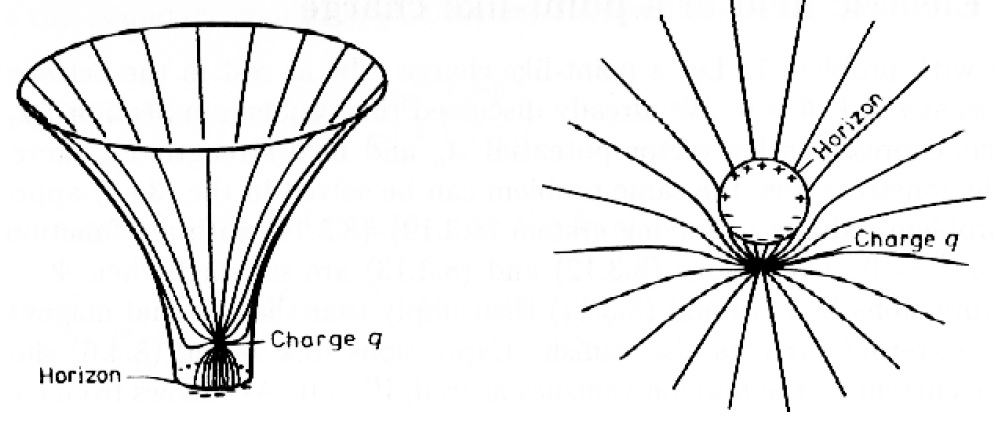
Electric field of a pointlike charge near a black hole
 المؤلف:
Heino Falcke and Friedrich W Hehl
المؤلف:
Heino Falcke and Friedrich W Hehl
 المصدر:
THE GALACTIC BLACK HOLE Lectures on General Relativity and Astrophysics
المصدر:
THE GALACTIC BLACK HOLE Lectures on General Relativity and Astrophysics
 الجزء والصفحة:
p 170
الجزء والصفحة:
p 170
 2-2-2017
2-2-2017
 2094
2094
Electric field of a pointlike charge near a black hole
Let a pointlike charge q be at rest near a Schwarzschild black hole at r = r0, θ = 0. The electric field created by this charge, found and Leaute and Linet [49], reads:
 (1.1)
(1.1)
where
 (1.2)
(1.2)
 (1.3)
(1.3)

Figure 1.1. The electric-field lines of force of a test charge q at rest in the Schwarzschild metric, in a φ = constant section: (left) lines of force on a curved surface whose geometry coincides with the section φ = constant of the Schwarzschild metric; (right) the same lines projected on a plane (‘bird’s-eye view’). The distribution of the fictitious surface charge σ H is shown on the horizon. The charge q is assumed to be positive.
The electric field E, defined as Ei = −α−1gi j At, j, is

 (1.4)
(1.4)
where eȓ and e ˆθ are unit vectors along the directions of r and θ, respectively.
It is easy to see that at the horizon Eθ → 0 so that electric lines of force intersect the horizon at right angles. The total flux of E across the horizon is zero (the black hole is uncharged). The pattern of electric lines of force is shown in figure 1.1.
The fictitious charge surface density at the boundary of the black hole is
 (1.5)
(1.5)
Let us bring the charge closer to the horizon (r0 → 2M). At a distance r >> r0 − 2M from the horizon, the lines of force become practically radial and the field strength tends to q/r 2. With the exception of a narrow region close to the horizon, the general picture is almost the same as for a charge placed at the center of the black hole.
 الاكثر قراءة في الثقوب السوداء
الاكثر قراءة في الثقوب السوداء
 اخر الاخبار
اخر الاخبار
اخبار العتبة العباسية المقدسة


